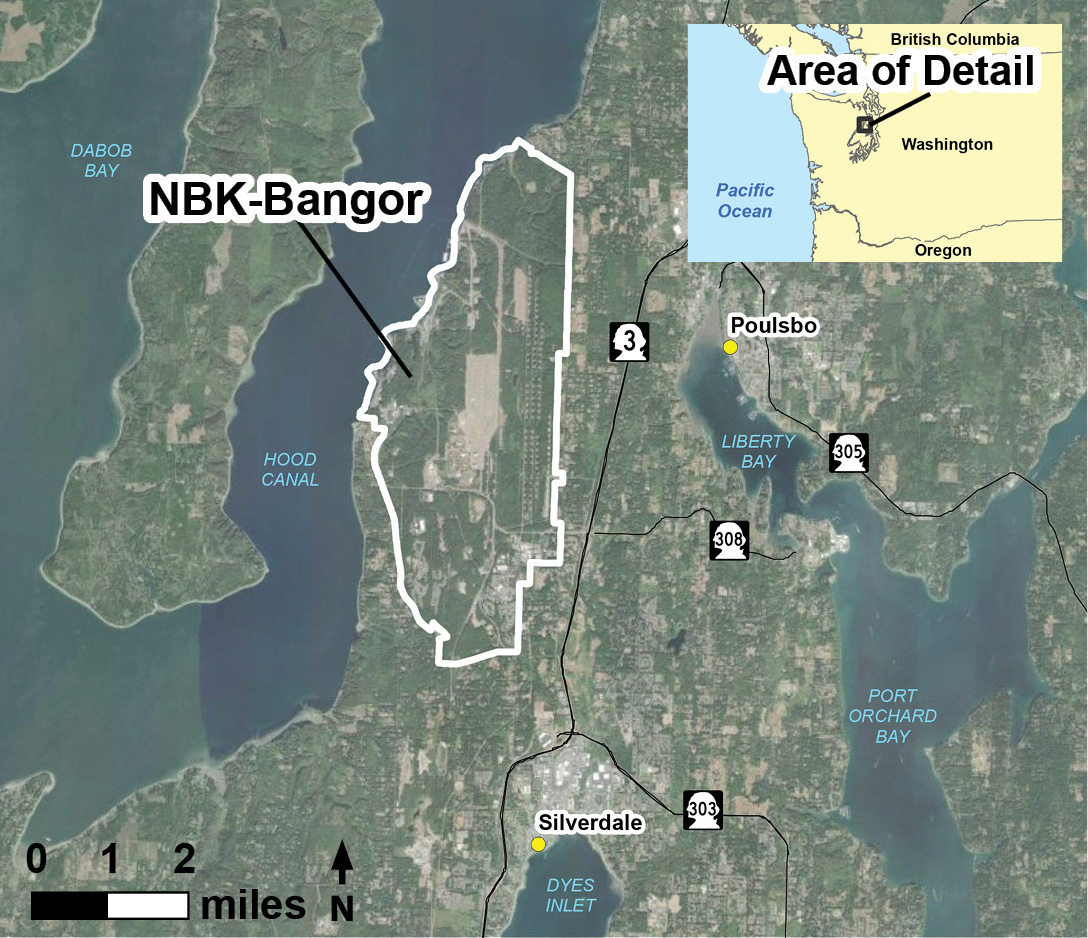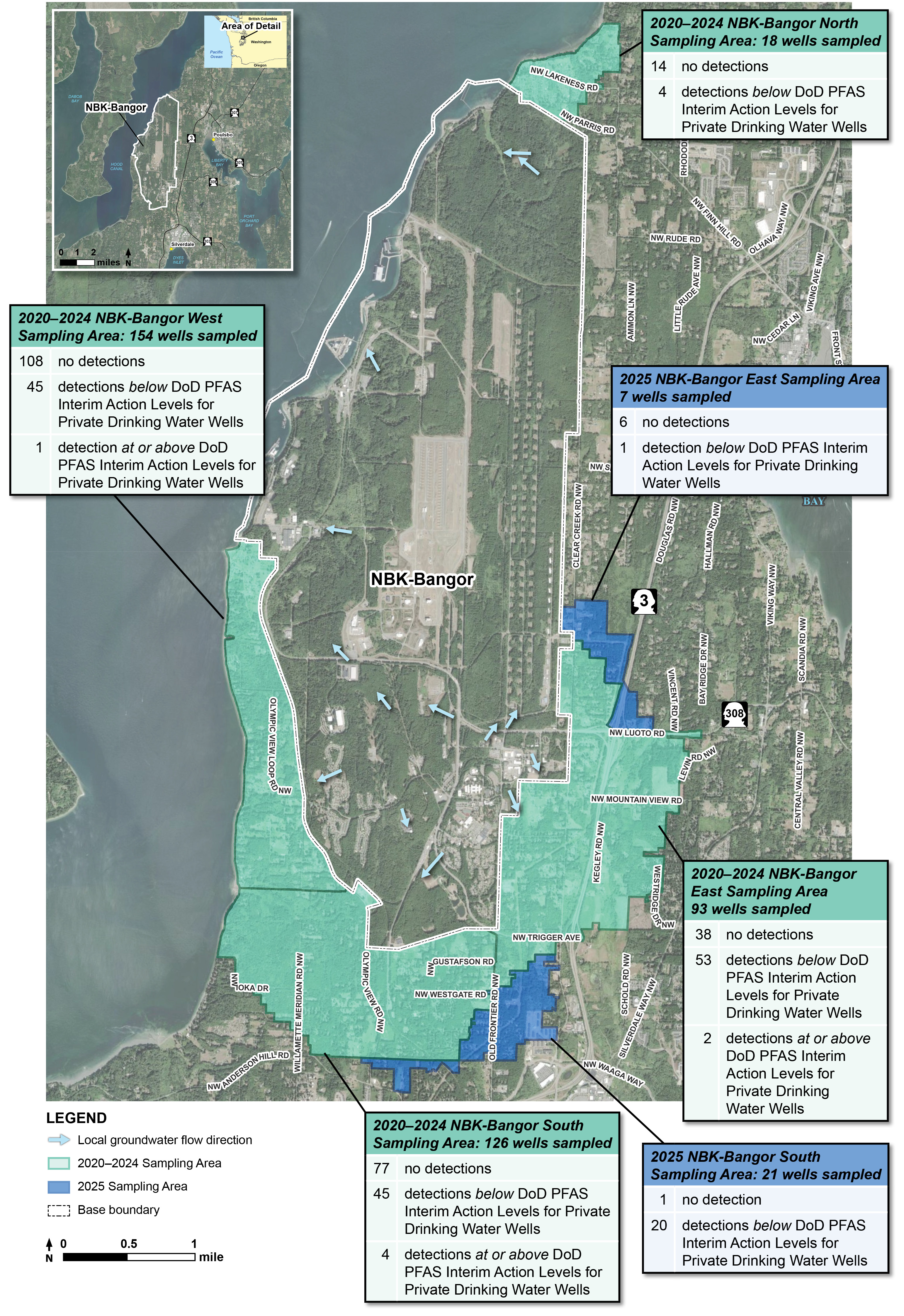The U.S. Navy is requesting property owner permission to sample private drinking water wells within the sampling area near Naval Base Kitsap-Bangor for per- and polyfluoroalkyl substances, or PFAS.
Property owners with a drinking water well in the sampling area may request sampling by leaving a message at 1-844-625-2647 (1-844-NBK-BNGR), or by sending an email to bangorpfas@jacobs.com. Please include your name, property address, and phone number. Appointments are currently being scheduled between 8 a.m. and 6 p.m. beginning Wednesday, Aug. 20 through Monday, Aug. 25, 2025 (additional times available upon request).
If your drinking water is provided by Silverdale Water District, the Navy does not need to sample your property.
Introduction
Per- and polyfluoroalkyl substances (PFAS) are a family of thousands of different chemicals that have been widely used in consumer products since the 1950s. PFAS are man-made and have been used in many household and industrial products because of their stain- and water-repellent properties. PFAS are now present virtually everywhere in the world. The Navy and Department of Defense (DoD) have developed policies to address past releases of PFAS at installations nationwide.
The most common activity that could have resulted in the historical release of PFAS to the environment at Naval Base Kitsap-Bangor (NBK-Bangor) (Figure 1) is the use of firefighting foam (specifically, aqueous film-forming foam, or AFFF) for testing, training, firefighting, and other life-saving emergency responses. Because of this historical use, PFAS are present in the groundwater at NBK-Bangor and have been detected in nearby drinking water wells that are located in the direction that the groundwater flows away from NBK-Bangor.
FIGURE 1: LOCATION MAP OF NBK-BANGOR

On April 26, 2024, the United States Environmental Protection Agency (EPA) published a final National Primary Drinking Water Regulation (NPDWR) establishing nationwide drinking water standards for certain PFAS under the Safe Drinking Water Act. The regulation applies to public drinking water systems. Operators of public drinking water systems regulated by the NPDWR have until April 2029, to meet these standards. In September 2024, DoD published “Prioritization of Department of Defense Cleanup Actions to Implement the Federal Drinking Water Standards for Per- and Polyfluoroalkyl Substances under the Defense Environmental Restoration Program,” which describes DoD’s plans to incorporate the EPA’s drinking water regulation into DoD’s ongoing PFAS cleanups and prioritize actions to address private drinking water wells with the highest levels of PFAS from DoD activities. Table 1 shows the levels that all of DoD, including the Navy, is authorized to use to address PFAS in private drinking water wells.
Table 1 presents the DoD PFAS Interim Action Levels for Private Drinking Water Wells. The DoD’s September 2024 policy memorandum can be found here.

Private Drinking Water Well Sampling Near NBK-Bangor
Certain PFAS have been detected in groundwater near NBK-Bangor above the DoD PFAS Interim Actions Levels for Private Drinking Water Wells (Figure 2). As a result, multiple sampling areas were established 1 mile in the direction that groundwater flows away from the locations of these detections. The Navy continues to offer sampling to all property owners whose drinking water comes from a well in the sampling area (Figure 2) and who have not been previously sampled by the Navy.
From 2020 through 2024, the Navy sampled 382 drinking water wells near NBK-Bangor. PFOA and/or PFOS were detected at two drinking water wells above 70 parts per trillion (ppt), the DoD interim action level at the time. In 2024, the Navy connected one property to Silverdale Water District public water system. No further action was recommended for the remaining property based on multiple rounds of sampling with no additional exceedances above the September 2024 DoD PFAS Interim Action Levels for Private Drinking Water Wells.
Due to the September 2024 DoD policy, the Navy re-evaluated on-base groundwater results and 2020-2024 off-base private drinking water well results. Based on this information, the Navy identified five additional off-base drinking water wells near NBK-Bangor above the DoD PFAS Interim Action Levels for Private Drinking Water Wells. One of these wells connected to Silverdale Water District public water system on their own accord. The Navy began the process for implementing an enduring solution for the remaining four properties in 2025. PFAS has not been detected in drinking water in any samples collected on-base.
During the re-evaluation due to the September 2024 policy, the Navy determined that the off-base drinking water sampling near NBK-Bangor should be expanded (Figure 2).
Additional drinking water well sampling was conducted in 2025. PFAS were not detected in any wells at or above the DoD PFAS Interim Action Levels for Private Drinking Water Well. To date, 419 wells have been sampled near NBK-Bangor (Table 2), including the 382 wells that were sampled from 2020 through 2024. Table 3 presents the individual PFAS results to date.

Table 3. NBK-Bangor - 2020-2025 Private Drinking Water Well Results
FIGURE 2: SAMPLING AREA

The Navy is requesting permission to sample certain drinking water wells located in the sampling areas shown on Figure 2. Records indicate that most of the properties in the sampling areas use a private or community well for drinking water. If your drinking water is provided by Silverdale Water District, the Navy does not need to sample at your property. You can contact Silverdale Water District with questions regarding its treatment and testing of drinking water.
Actions Based on Private Drinking Water Sampling Results
The preliminary results from the private drinking water well sampling near NBK-Bangor are expected approximately 30 days after collecting the samples. The Navy provides notification to the property owners and tenants (if possible) of their drinking water results and any follow-up actions, if needed.
The Navy will address PFAS in drinking water wells in keeping with the DoD policy:
PFAS at or above the DoD PFAS Interim Actions Levels for Private Drinking Water Wells (Table 1). The Navy will work with property owners to implement an enduring solution as soon as possible. Options for potential enduring solutions may include connection to public water supply or installation of a drinking water treatment system. For any drinking water wells with PFOA and PFOS, individually or combined, above 70 ppt, the Navy will provide bottled water for drinking and cooking to property owners or tenants until an enduring solution is implemented.
PFAS below the DoD PFAS Interim Action Levels for Private Drinking Water Wells (Table 1). For final remedial actions, the Navy will address drinking water down to EPA NPDWR or background levels in accordance with Comprehensive Environmental Response, Compensation, and Liability Act (CERCLA) requirements.
Identification of PFAS Releases at NBK-Bangor
A PFAS Preliminary Assessment (PA) was finalized in 2020. The PA evaluated 35 areas and identified 23 as potential PFAS release areas for investigation as part of a Site Inspection (SI). One potential release area, Floral Point, was not investigated during the SI because the investigation would damage the landfill cap. Field investigations were completed in 2022 at or near 22 potential release areas (Figure 3). Of the 22 potential PFAS release areas, four sites were recommended for Remedial Investigation (RI) and 18 were recommended for no further investigation at this time (Table 4). The RI is underway, and field investigations are planned to start in late 2025.
The PFAS release areas investigated at NBK-Bangor are depicted on Figure 3; Table 4 lists the release areas investigated during the SI and RI along with current status. The Navy will continue on-base PFAS investigations following the CERCLA process and evaluate if additional actions are needed. All final documents are posted to the Navy’s CERCLA Administrative Record available at https://go.usa.gov/xh29v.
FIGURE 3: PFAS RELEASE AREAS


For additional information or questions, please contact the NAVFAC Northwest Public Affairs Officer at (360) 340-5592 or navfacnwpao@us.navy.mil.